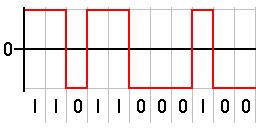 | ||
In telecommunication, a line code is a code chosen for use within a communications system for transmitting a digital signal down a line. Line coding is often used for digital data transport. Some line codes are digital baseband modulation or digital baseband transmission methods, and these are baseband line codes that are used when the line can carry DC components.
Contents
Line coding consists of representing the digital signal to be transported, by a waveform that is appropriate for the specific properties of the physical channel (and of the receiving equipment). The pattern of voltage, current or photons used to represent the digital data on a transmission link is called line encoding. The common types of line encoding are unipolar, polar, bipolar, and Manchester encoding.
Line coding
For reliable clock recovery at the receiver, one usually imposes a maximum run length constraint on the generated channel sequence, i.e., the maximum number of consecutive ones or zeros is bounded to a reasonable number. A clock period is recovered by observing transitions in the received sequence, so that a maximum run length guarantees such clock recovery, while sequences without such a constraint could seriously hamper the detection quality.
After line coding, the signal is put through a "physical channel", either a "transmission medium" or "data storage medium". Sometimes the characteristics of two very different-seeming channels are similar enough that the same line code is used for them. The most common physical channels are:
Some of the more common or binary line codes include:
Each line code has advantages and disadvantages. The particular line code used is chosen to meet one or more of the following criteria:
Disparity
The disparity of a bit pattern is the difference in the number of one bits vs the number of zero bits. The running disparity is the running total of the disparity of all previously transmitted words.
Unfortunately, most long-distance communication channels cannot reliably transport a DC component. The DC component is also called the disparity, the bias, or the DC coefficient. The simplest possible line code, unipolar, gives too many errors on such systems, because it has an unbounded DC component.
Most line codes eliminate the DC component – such codes are called DC-balanced, zero-DC, or DC-free. There are three ways of eliminating the DC component:
Polarity
Bipolar line codes have two polarities, are generally implemented as RZ, and have a radix of three since there are three distinct output levels One of the principle advantages of this type of code, is that it can completely eliminate any DC component. This is important if the signal must pass through a transformer or a long transmission line.
Unfortunately, several long-distance communication channels have polarity ambiguity. To compensate, several people have designed polarity-insensitive transmission systems. There are three ways of providing unambiguous reception of "0" bits or "1" bits over such channels:
Synchronization
Line coding should make it possible for the receiver to synchronize itself to the phase of the received signal. If the synchronization is not ideal, then the signal to be decoded will not have optimal differences (in amplitude) between the various digits or symbols used in the line code. This will increase the error probability in the received data.
Biphase line codes require at least one transition per bit time. This makes it easier to synchronize the transceivers and detect errors, however, the baud rate is greater than that of NRZ codes.
Other considerations
It is also preferred for the line code to have a structure that will enable error detection. Note that the line-coded signal and a signal produced at a terminal may differ, thus requiring translation.
A line code will typically reflect technical requirements of the transmission medium, such as optical fiber or shielded twisted pair. These requirements are unique for each medium, because each one has different behavior related to interference, distortion, capacitance and loss of amplitude.
Common line codes
Optical line codes:
